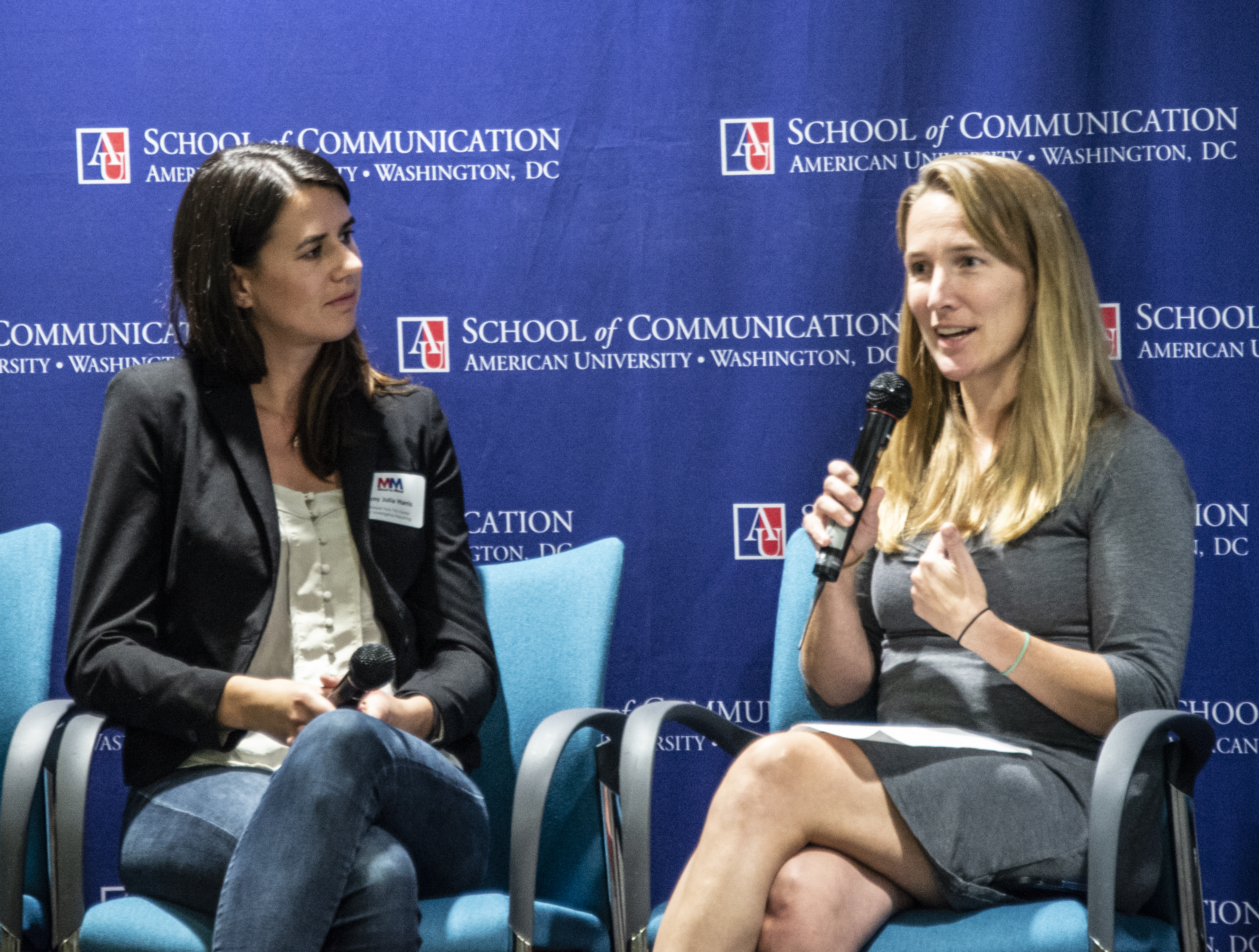Categories
NewsReporters and researchers can collaborate more extensively to shed light on issues the country’s workforce is facing, panelists said Friday at the Mind to Mind symposium.
Journalists typically call academics to get quotes for their stories, and academics call journalists to ask them to write about their research papers, Christa Scharfenberg, CEO of Reveal from The Center for Investigative Reporting, said to open the event.
“We think there’s an opportunity to collaborate much more deeply,” she said.
Mind to Mind 2018 was the second symposium aimed at bringing together researchers and reporters to discuss America’s workforce. It was sponsored by Reveal in collaboration with the Investigative Reporting Workshop and American University’s School of Communication.
Panel discussions at the event, held at American University in Washington, focused on labor issues, including workplace safety in the Trump era, gender dynamics of nonpromotable office work and the #MeToo movement that called attention to sexual harassment in the workplace.
Margaret Janz, a librarian at the University of Pennsylvania and the Data Refuge project, said during a panel about collaboration between journalists and academics that after Donald Trump was elected president, she decided to scrape government data about climate change. She said she wanted to preserve it in case the new administration made it unavailable.
Reveal data reporter Sinduja Rangarajan and Donald Tomaskovic-Devey, director of the Center for Employment Equity, discussed their collaboration on a project that examined diversity at Silicon Valley technology companies. Their goal was to democratize the data, Tomaskovic-Devey said.
Rangarajan said she was pleasantly surprised at how quickly Tomaskovic-Devey was able to complete his analysis of the data, and Tomaskovic-Devey said he appreciated the opportunity to be quoted in greater context than usual.
“I think most academics are familiar with journalists as people on a deadline who just want a quote,” he said.
Megan Twohey, an investigative reporter for The New York Times, said the investigation by her and others into allegations of extensive sexual harassment by Hollywood power player Harvey Weinstein was an example of reporting that carefully examined facts without believing tips wholesale. The #MeToo movement and journalism sometimes are improperly conflated, Twohey said.
“We’re not there to sort of launch campaigns,” she said. “We’re there to do what we do with any kind of investigative journalism, which is any sort of opportunity to hold the powerful accountable, give voice to the voiceless and report without fear or favor.”
Academics know what causes harassment, said Louise Fitzgerald, a professor emeritus of gender and women’s studies at the University of Illinois at Urbana-Champaign. She said bad behavior thrives in masculinized job environments with many men in positions of power and a culture that tolerates harassment.
The president of the National Women’s Law Center, Fatima Goss Graves, said advocates who use the phrase “believe women” about sexual misconduct are not suggesting that people believe accusations without evidence. Instead, she said the advocates are trying to combat the cultural presumption that women should not be believed.
“When you decide someone’s lying, you don’t have to investigate,” Graves said. “You don’t have to have a hearing that’s set up fairly.”
Emma Brown, an investigative reporter for The Washington Post, talked with Reveal reporter Amy Julia Harris about breaking the story of Christine Blasey Ford’s assault allegations against then-Supreme Court nominee Brett Kavanaugh. Brown said she makes no promises to sources about what could happen once a story is published or whether it even will be published at all.
It’s important to be “upfront about your role as a journalist,” Brown said. “You’re going to vet the person’s story, ask hard questions, ask about the person’s motivations for telling that story.”
In a session about worker safety, Jordan Barab, a former deputy assistant secretary of the Occupational Safety and Health Administration, said he uses his blog, Confined Space, to amplify relevant stories published by small news outlets. He puts names and stories to statistics about people hurt by unsafe working conditions.
Humanizing statistics is also the goal of Rebecca Moss, a reporter who covers energy and the environment at the Santa Fe New Mexican. As the Trump administration has rolled back requirements that large companies make detailed reports of workplace injuries to OSHA, Moss said she tries to give voice to workers who feel like they’ve been silenced.
“Certainly, workers who are trying to support their families and bring home a paycheck don’t feel like they can speak up in this kind of environment,” Moss said.
Reveal reporter Will Evans said reporters and academics could collaborate to fill gaps in government information about workplace safety. Although the Obama administration talked about creating a publicly accessible workplace injury database, none ever materialized, Evans said.
Because workers can request their own records, Evans said one reporting approach might be for reporters and academics to work with employees from one industry to create such a database.
Panelist Lise Vesterlund, an economics professor at the University of Pittsburgh, tied together academia and journalism by offering a perspective on why news organizations’ managers are overwhelmingly male.
Women more frequently volunteer for and are asked to do necessary tasks — like taking notes at meetings, organizing office parties or serving on committees — that don’t lead to promotions, Vesterlund said. When they’re asked, Vesterlund said they typically say yes. Men, therefore, advance more quickly, resulting in more men occupying the top rungs of news organizations.
“I think unless we do something structural, like paying attention to how we allocate tasks, it will remain that way,” she said.
This story was co-published with Reveal from The Center for Investigative Reporting, a nonprofit news organization based in the San Francisco Bay Area. Learn more at revealnews.org and subscribe to the Reveal podcast, produced with PRX, at revealnews.org/podcast





